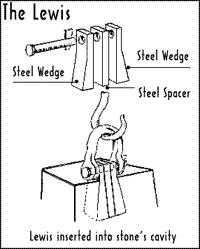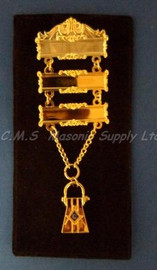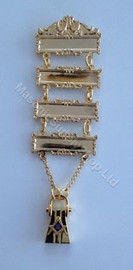Lewis Jewel 4 bar Gold Finish
- SKU:
- JWL-4BAR
- Shipping:
- Calculated at Checkout
Four Bar Lewis Jewel
Great Grandfather, Grandfather, Father, and Son
Price includes
Includes
Free Laser Engraving on the front of your bars
Free Pocket jewel Mount & wallet !!
Our engraving is done in a bold black font which makes it very easy to read they are Laser engraved on a gold insert as per pictures
Engravings
Your names can be laser engraved on each bar of the Lewis Jewel however, the more characters you have engraved, the smaller the font will have to be to fit them on the bar.
We recommend you only have your Names and Initiation dates (Traditional) or your Name and Lodge name on the bars.
Example
Top Bar Line 1 Bro John Doe
Top Bar Line 2 10/01/2014
Note...Dates will only be engraved in numbers only 10/01/2014 not letters IE September or November (due to limited space on bars to engrave)
PLEASE FILL OUT TEXT BOXES AT TOP OF PAGE
Please make sure your spelling is correct as we will engrave exactly as you enter it in the text box
Note # is an incorrect abbreviation for the Lodge Number, No. is the correct abbreviation
The Lewis Jewel Explained
The Lewis Jewel may be worn by a Mason, if at the time of his Initiation, his father was a Mason in good standing (the initiate of a deceased father–in good standing at the time of his demise–would also qualify).
The Lewis Jewel consists of two bars connected by chains:
- The upper bar contains the name of the father and date of his Initiation.
- The lower bar, the name of the son and date of his Initiation.

A LEWIS is a simple but ingenious device employed by operative Masons to raise heavy blocks of dressed stone into place. It consists of three metal parts: two wedge-shaped side pieces, and a straight centre piece, that fit together (tenon). A dovetailed recess is cut into the top of the stone block (mortise). The two outer pieces are inserted first and then spread by the insertion of the centrepiece. The three parts are then bolted together, a metal ring or shackle is attached and the block is hoisted by hook, rope and pulley. By this means, the block is gripped securely. Once set in its place in the structure, the lewis is removed leaving the upper surface smooth with no clamp or chains on the outside to interfere with the laying of the next course. Our ancient operative brethren used this tool as early as the Roman era. Stones with the mortised cavity for the insertion of a lewis have been found in Hadrian's Wall built c. 121-127 CE. Archaeologists have found further evidence of its use by the Saxons in England in buildings constructed in the 7th century. The origin of the term 'lewis' for this device is uncertain. Some authorities trace its etymology to the French levis from lever – to lift, hoist, raise; and louve – a sling, grip or claw for lifting stones.
Whence is the word derived?
Q. What's a Mason's Sons Name
A. Lewis
The Wilkinson MS – c 1730 / 1740
Masonic historians conclude that the term came into use in the 18th century. The Lecture in the Second Degree published by William Preston in the 1780s contains a lengthy discourse on the Lewis.
WM – Brother J.W., How were the sons of craftsmen named?
JW – To the son on whom these honours were bequeathed, the appellation of Lewis was given, that from henceforth he might be entitled to all the privileges which that honour conferred, W. Sir.
A doggerel verse in 'The Deputy Grand Master's Song' printed in the second edition of Anderson's Constitutions published in 1738, written as a sort of 'loyal toast' to be sung by the brethren around the festive board:
"Again let it pass to the ROYAL lov'd NAME,
Whose glorious Admission has crown'd all our Fame:
May a LEWIS be born, whom the World shall admire,
Serene as his MOTHER, August as his SIRE."
A paragraph in a version of the Junior Warden's Lecture used in the Grand Lodge of England dating from 1801 gives this instructive explanation: “The word Lewis denotes strength, and is here depicted by certain pieces of metal dovetailed into a stone, which forms a cramp, and enables the operative Mason to raise great weights to certain heights with little encumbrance, and to fix them in their proper bases. Lewis, likewise denotes the son of a Mason; his duty is to bear the heat and burden of the day, from which his parents, by reason of their age, ought to be exempt; to help them in time of need, and thereby render the close of their days happy and comfortable; his privilege for so doing is to be made a Mason before any other person however dignified.”
Honour thy father...
In the days of operative Masonry, it was a great source of pride when a son followed in his father's footsteps and was Entered as an Apprentice, his name 'entered' on the roll, and thereby admitted to the lodge. To study his father's skills and learn to use his father's tools were manifest expressions of the greatest honour and esteem a son could pay. It was common to carry on the tradition through several generations in the same family.
It is a heart-warming day when a young man first shows interest in Freemasonry and asks his father how he might become a Mason, and it is a proud day when that son, in the fullness of time, is admitted a member of his father's lodge by Initiation.
To moralize on...
On the day that King Solomon laid the foundation stone of the Temple, beginning the construction of the great building project conceived by his father David, but given to his son to complete, the last words of King David may have come to his mind. When the time of David's death drew near, he gave his last charge to his son Solomon: I am going the way of all the earth. Be strong and show yourself a man. (1 Kings 2: 1)








